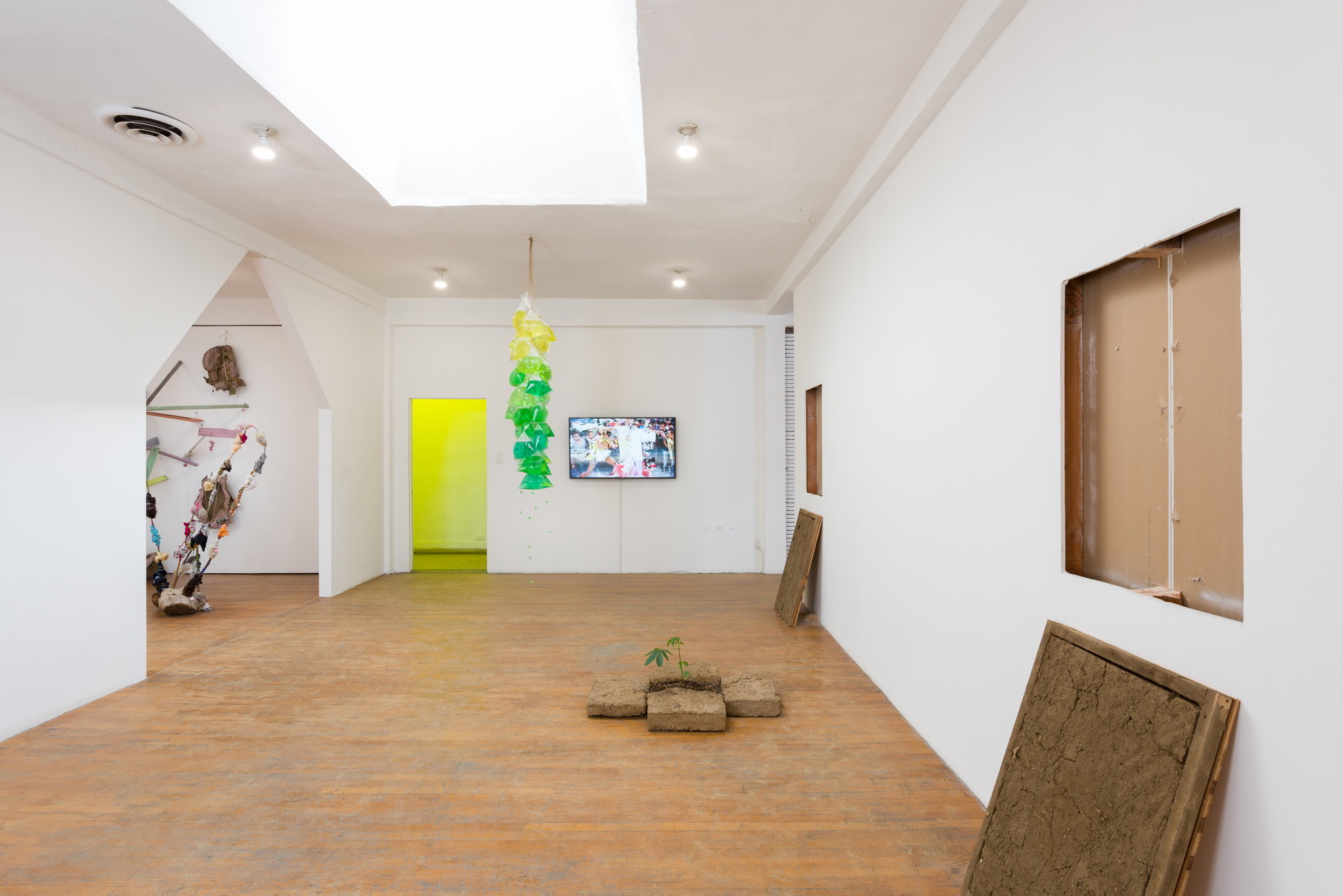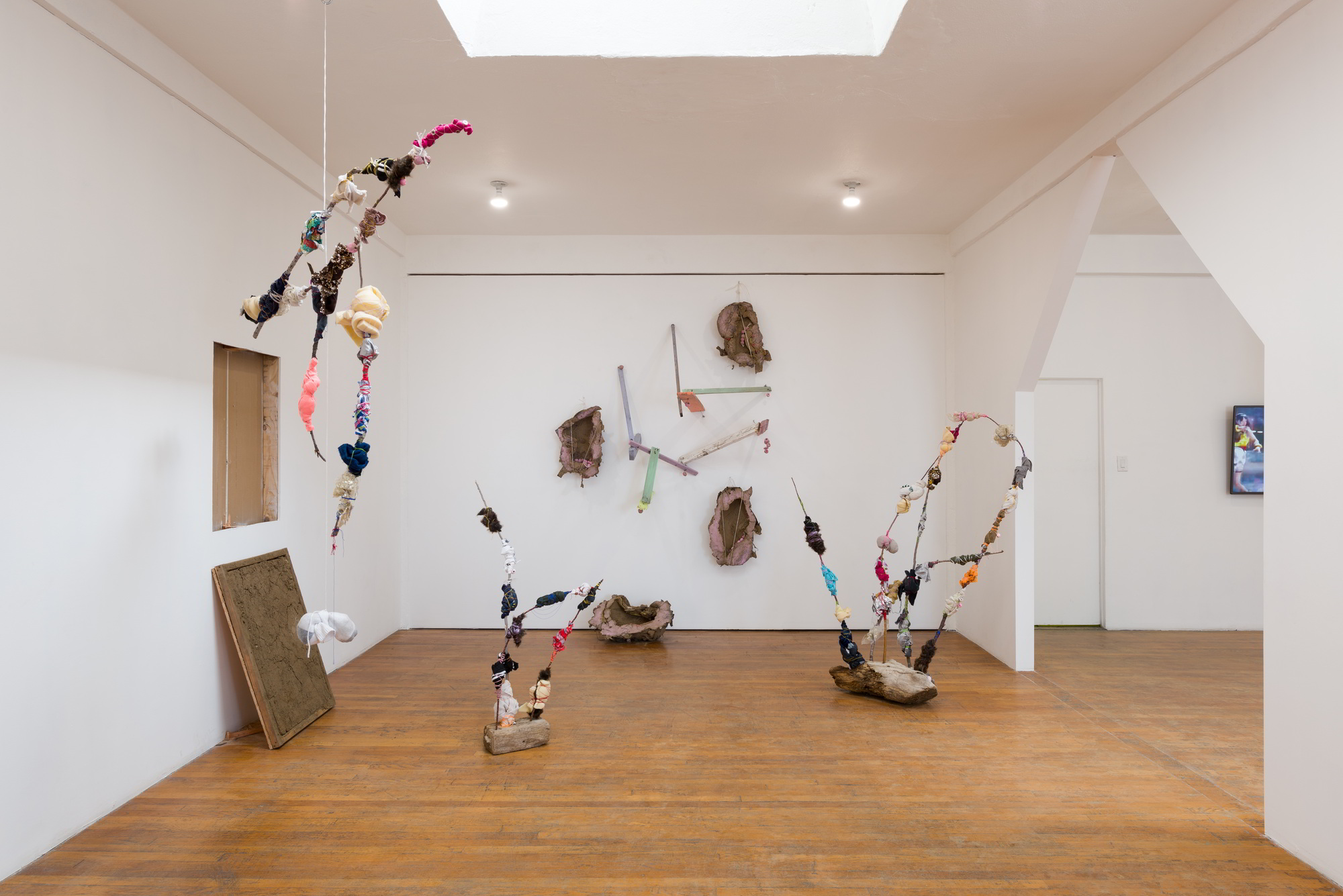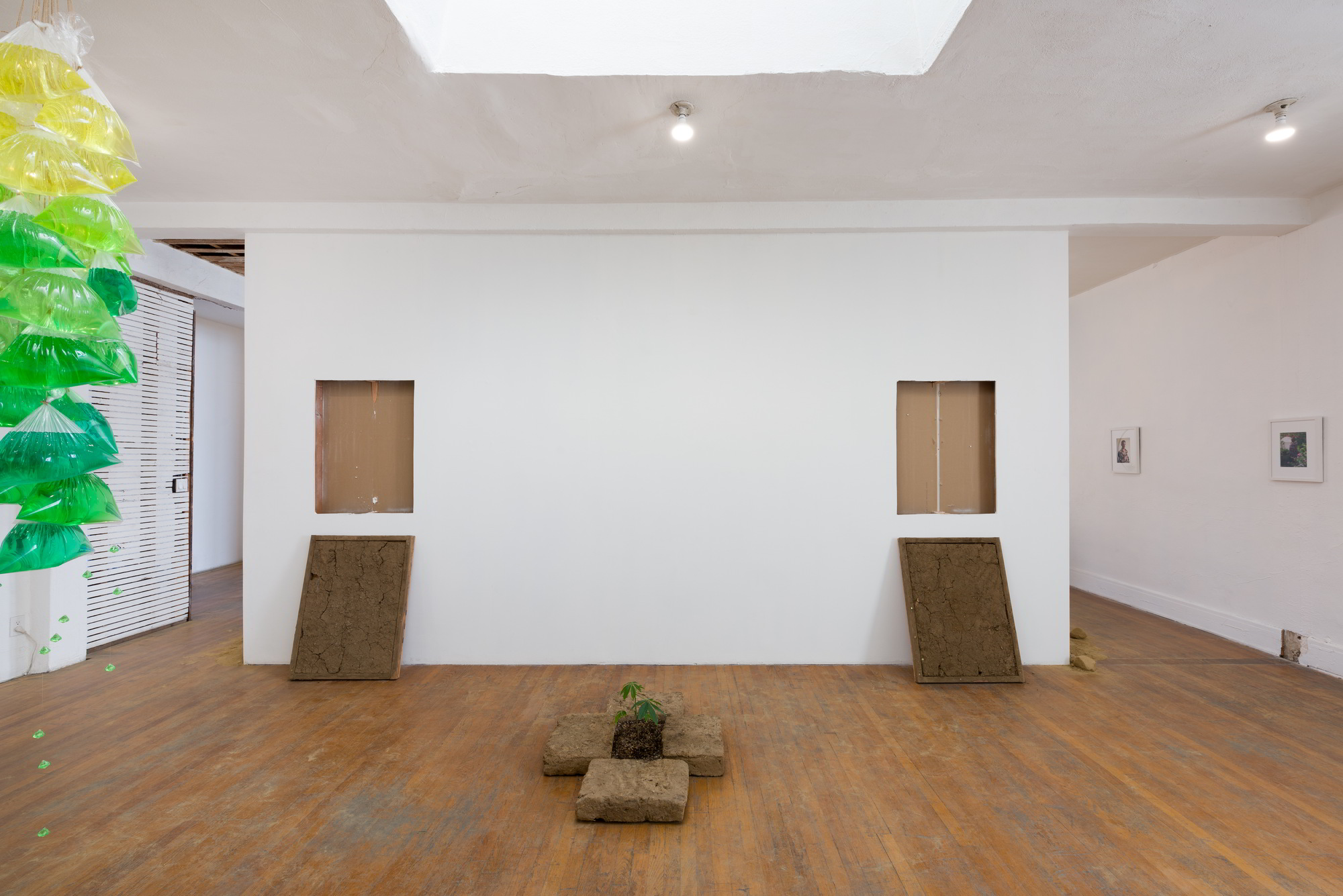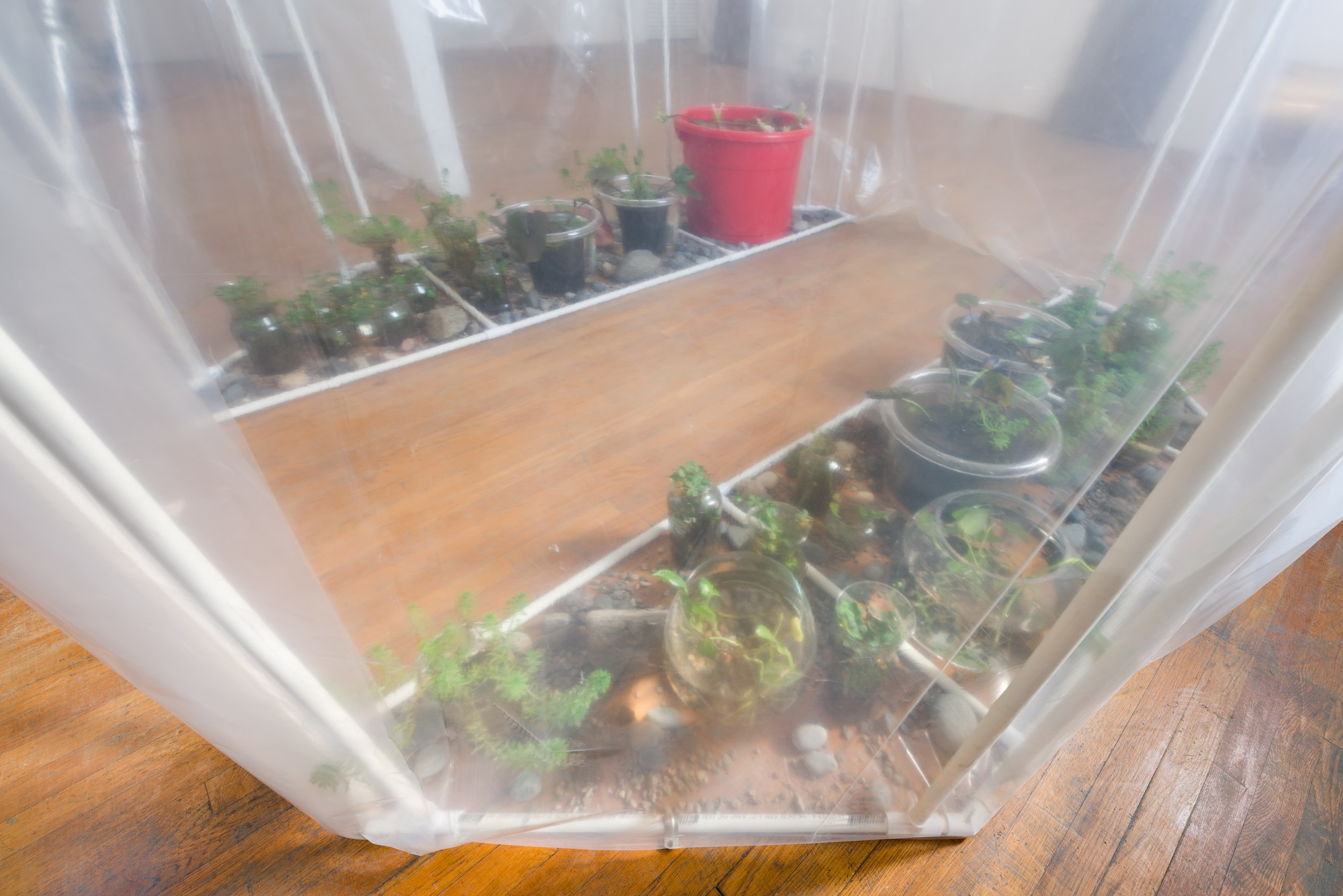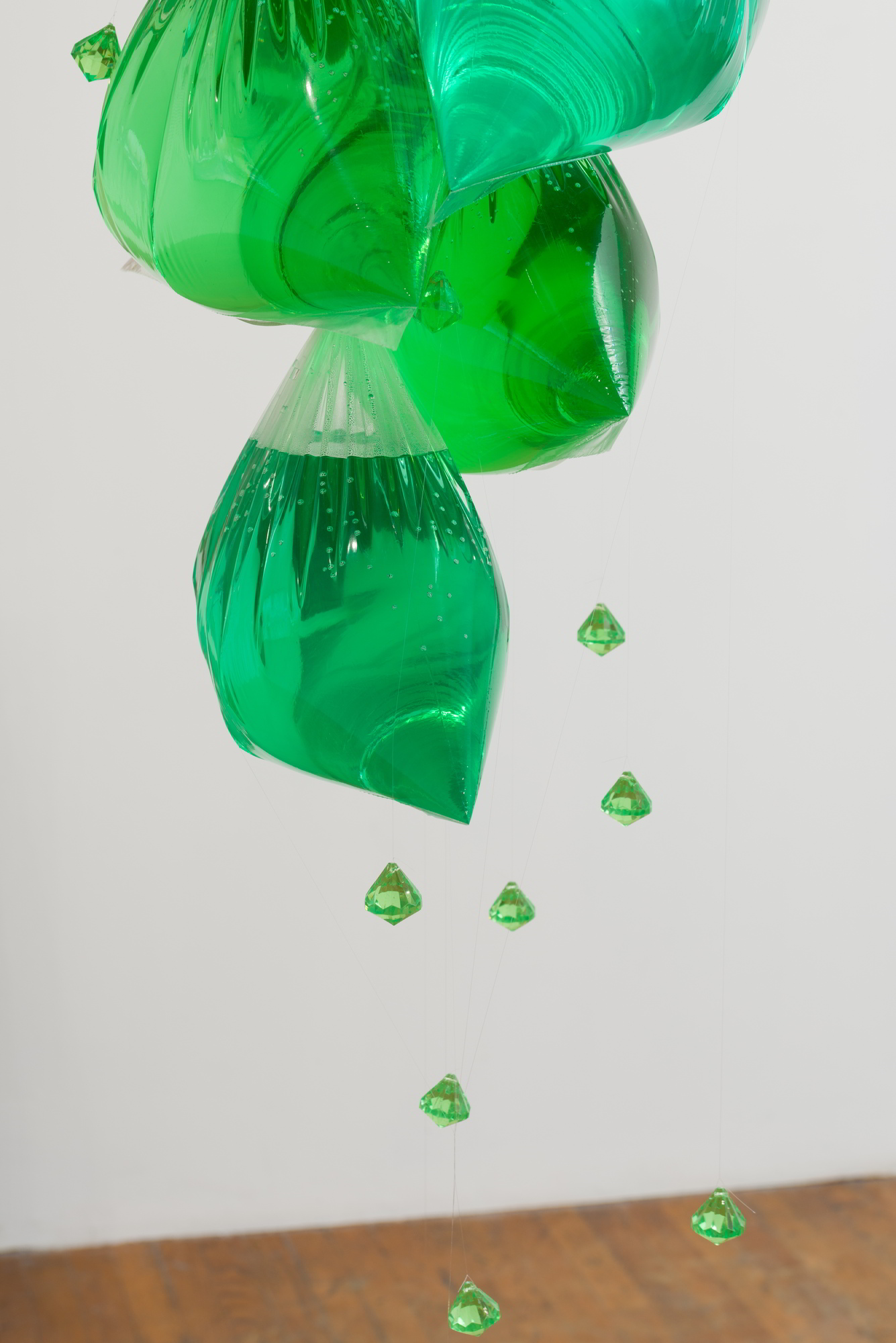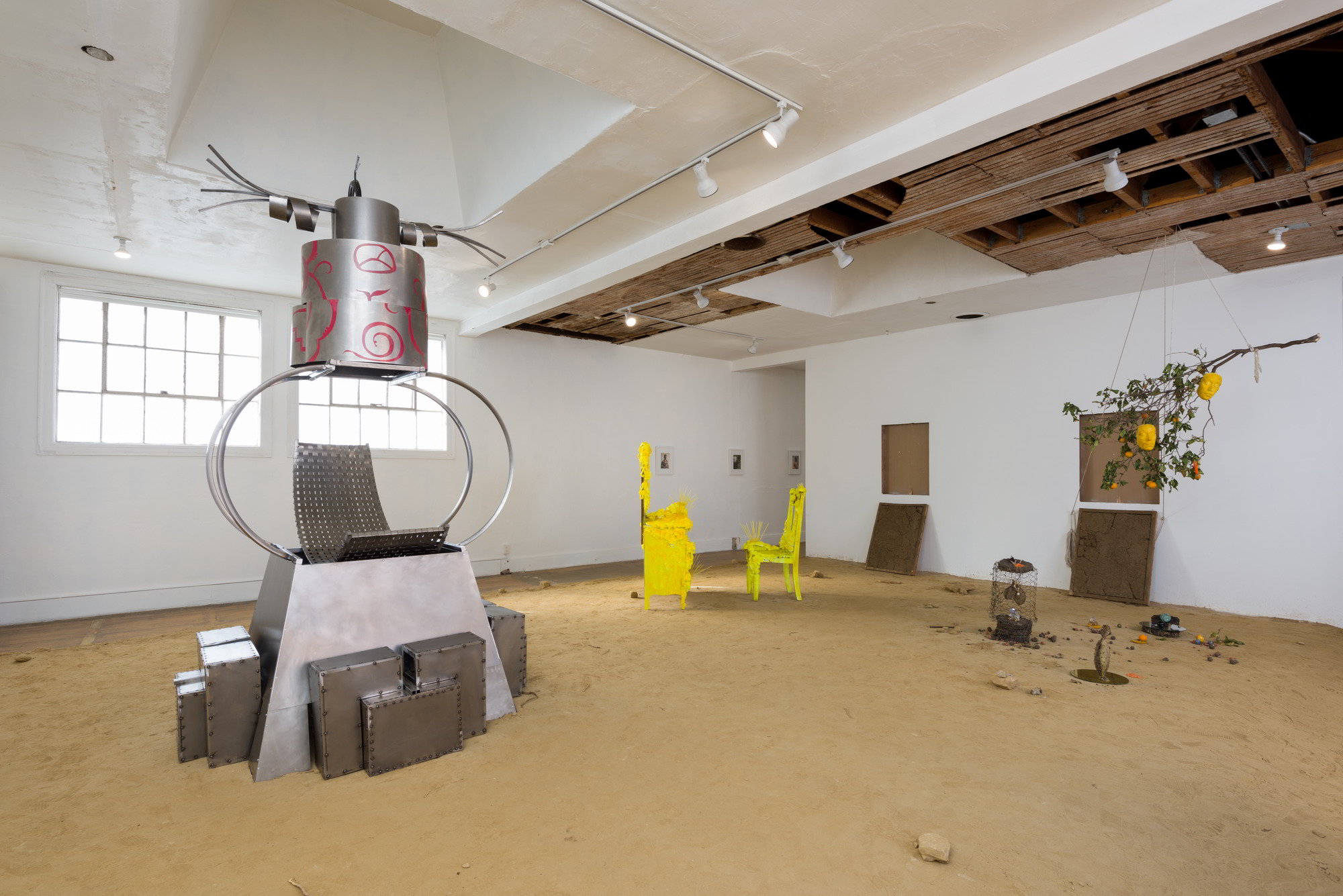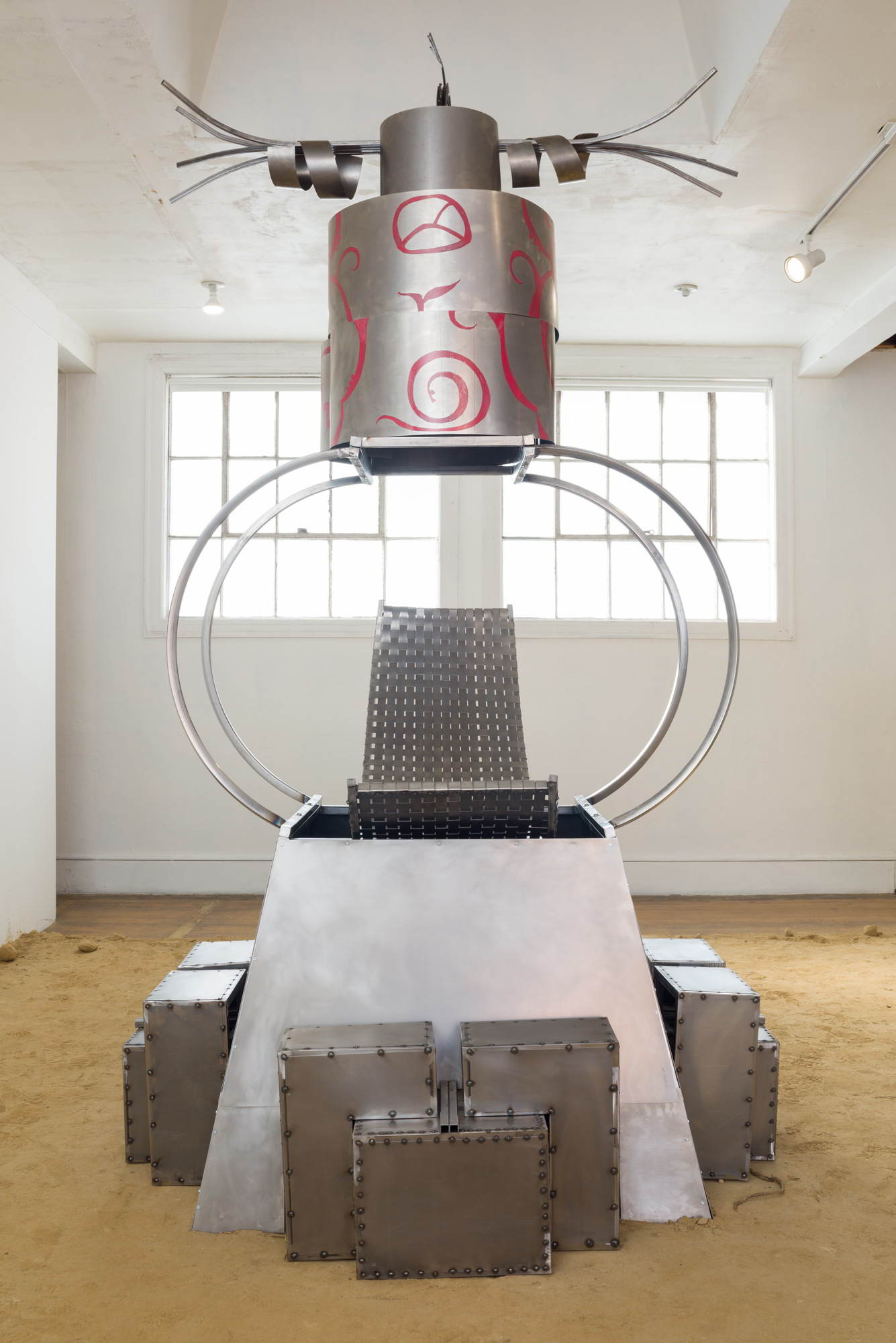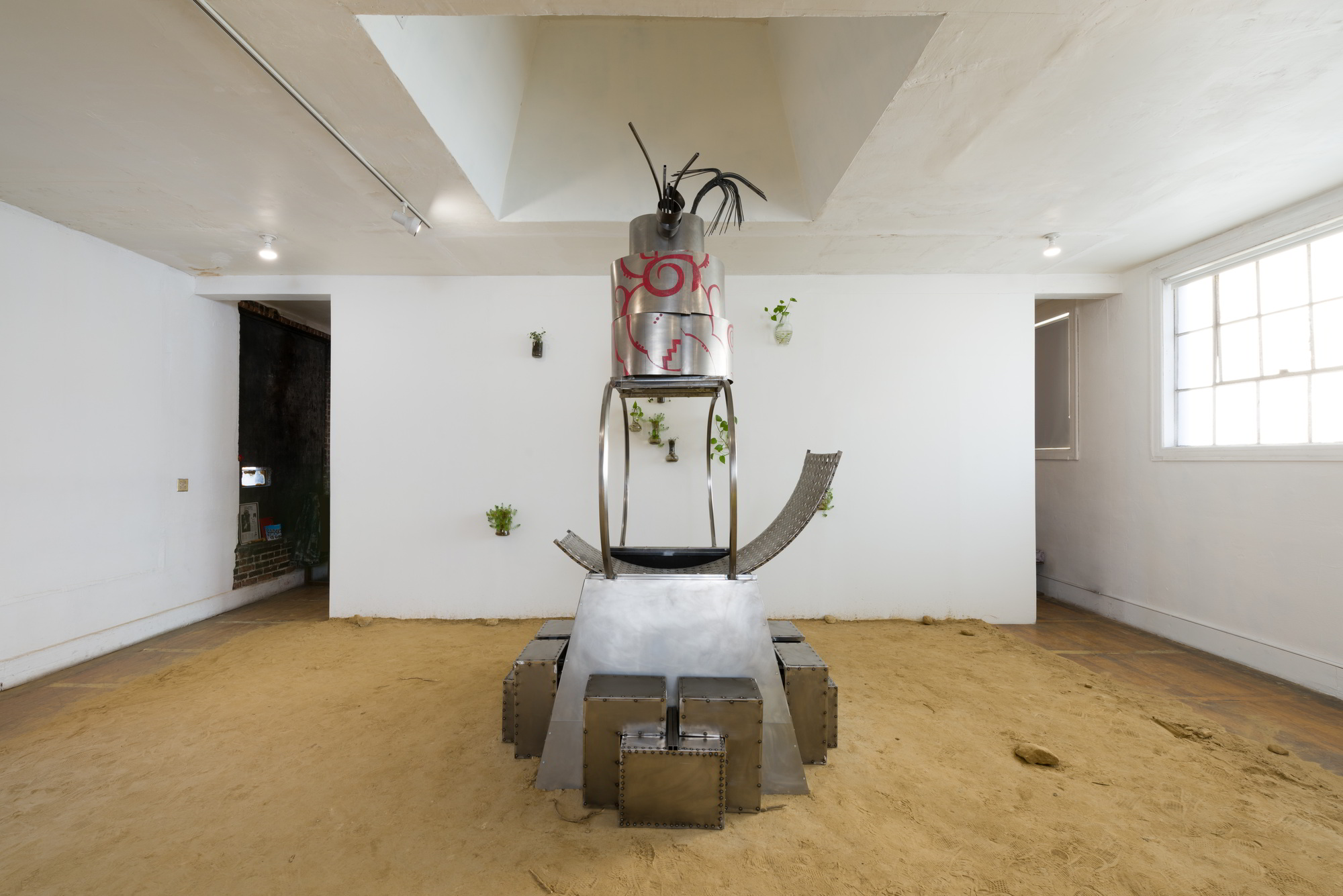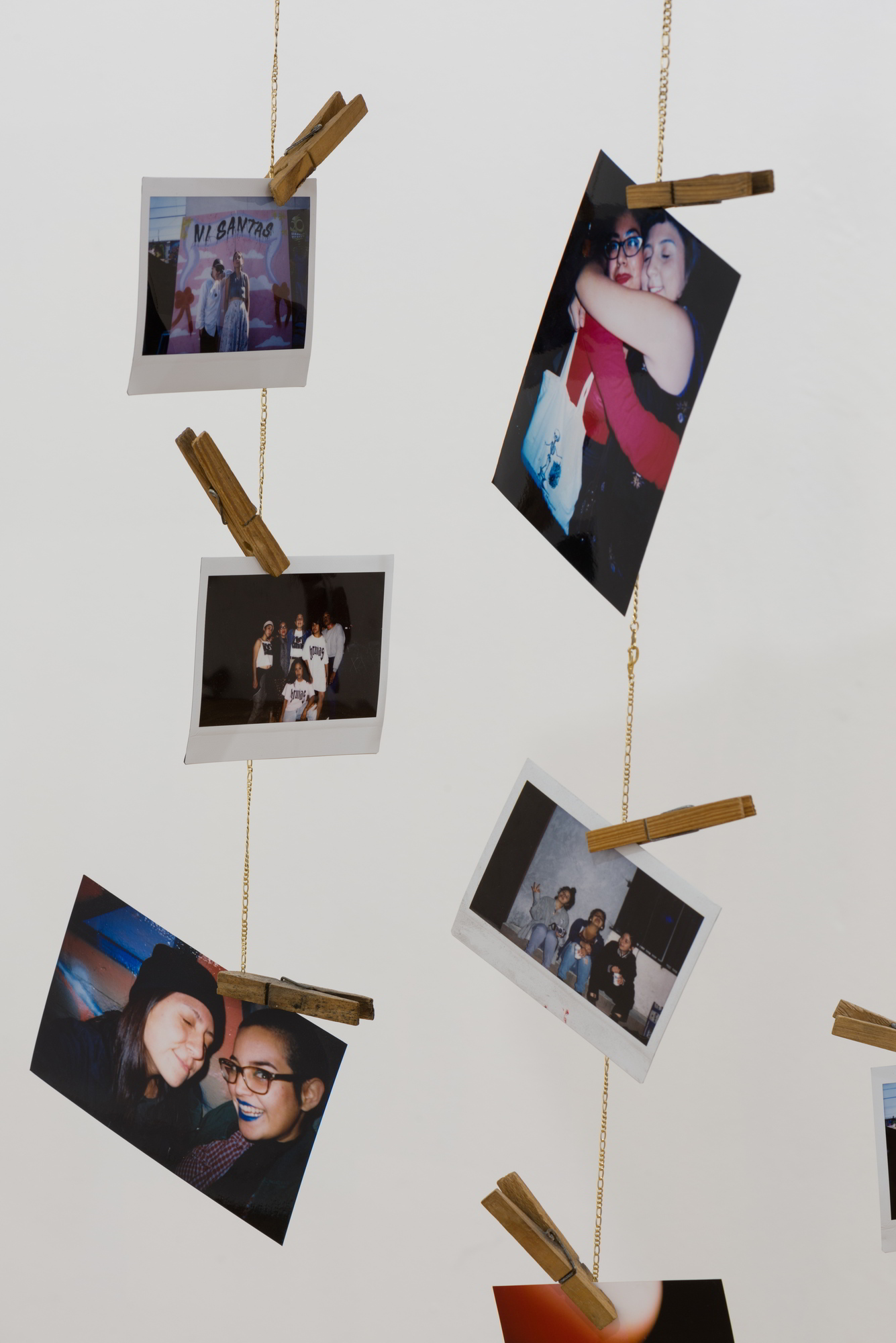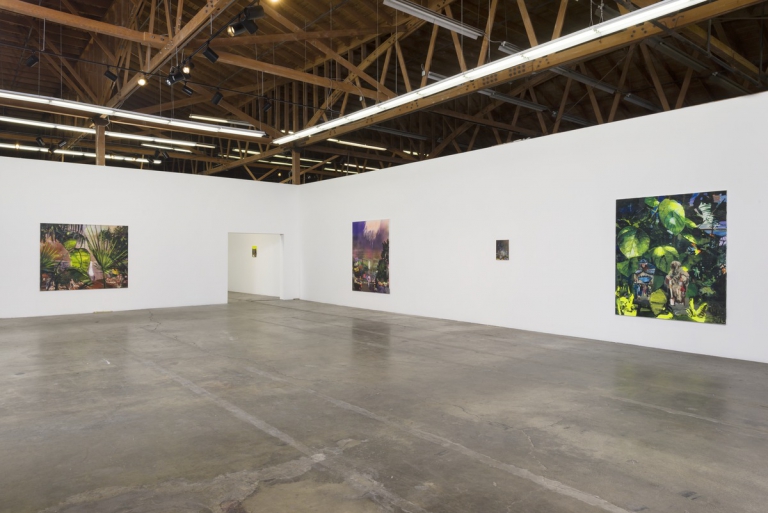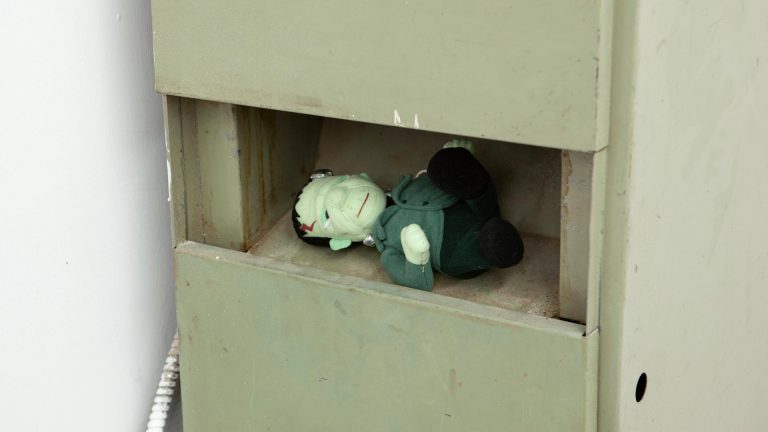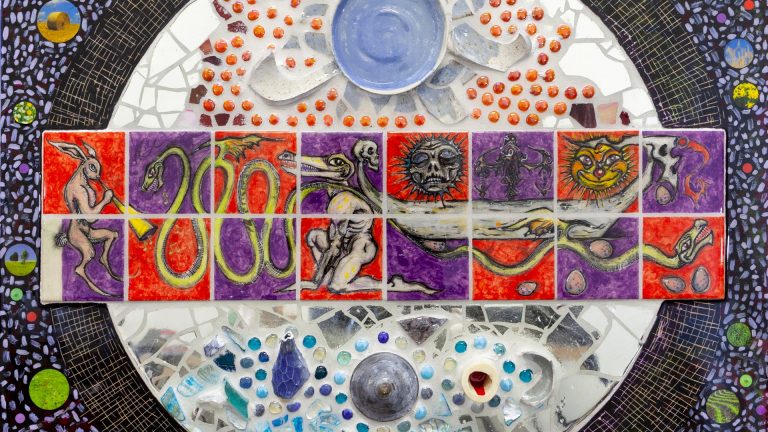Artists: Beatriz Cortez and Rafa Esparza (with Fabián Guerrero, Sebastián Hernández, María Maea, Rubén Rodríguez, Gabriela Ruiz, and Brenzy Solorzano)
Exhibition title: Pasado mañana
Venue: Commonwealth & Council, Los Angeles, US
Date: September 9 – October 21, 2017
Photography: all images copyright and courtesy of the artists and Commonwealth & Council, Los Angeles
Commonwealth and Council presents “Pasado mañana,” an exhibition of new work by Beatriz Cortez and Rafa Esparza. Together, they posit immigrant labor as a foundation for building a future in which multiple imaginaries of gender, race, class, and culture become possible. “Pasado mañana,” Spanish for “the day after tomorrow,” translates literally as “when tomorrow has passed.” Cortez and Esparza stage the potential inherent to this special temporality—anchored in the future perfect tense and all its poetic implications—where a collective, nomadic subjectivity is not only imaginable, but flourishes. This is their third collaborative exploration of this futurity, following exhibitions at UCR ARTSblock and Ballroom Marfa earlier this year.
Multiplicity of time and space recurs throughout Cortez’s practice, which navigates the simultaneity of immigrant experience as a truly critical nexus, with its differing and often competing versions of modernity, urbanity, technology, and culture. For Cortez, the spaceship provides what time machines and fortune tellers have elsewhere: a protective clairvoyance through which to chart and better understand what could otherwise become an intractable state of cognitive dissonance. The development of formal and spatial practices adequate to the experience of simultaneity grounds the exhibition. Esparza mounts a complex intervention in the gallery’s architecture, partially replacing, partially reinforcing its white walls and wooden floors with adobe—a material process deeply imbued with its own time and history. Both content and context, this reconstructive gesture constitutes a tableau of historical and personal meaning, an act of radical affirmation, and a platform for expansive engagement. For these adobe walls, Esparza has invited six queer artists (Fabián Guerrero, Sebastián Hernández, María Maea, Rubén Rodríguez, Gabriela Ruiz, and Brenzy Solorzano) of the next generation to show work alongside portraits he has painted of them, engaging in an artistic dialogue with these artists who exist in the present, but tell of the future.
Water lilies grow there. The system engineered for their cultivation in the gallery complicates this “future perfect,” introducing a circular idea of time that includes preserving ancient knowledge in generosity toward futures not yet imagined, despite the colonial obstacles that must be overcome for this gift to survive. The Mayan king Pakal wore water lilies in his headdress—symbolizing the rivers, streams, and waterfalls that would run in his kingdom, but also its technological advances in the field of agriculture. The labor of cultivating nature, so instrumental for the Maya in working the earth to build monumental precincts of spiritual depth and aesthetic pleasure, continues to underlie the immigrant experience. Immigrant gardeners, all over Los Angeles, put into practice different forms of ancient and contemporary knowledge and labor. As in their previous collaboration, “Nomad 13,” Cortez and Esparza are also gardeners here. Their combined labor nurtures these flowers—brimming with aspirations, ancient history, and commercial and aesthetic value—to thrive in circumstances of their choosing.
Beatriz Cortez (b. 1970, El Salvador) is a Los Angeles-based artist and scholar. Her work is currently included in the exhibition “Mundos Alternos: Art and Science Fiction in the Americas” at UCR (University of California, Riverside) ARTSblock, Riverside, CA, as part of Pacific Standard Time: LA/LA; “Tierra. Sangre. Fuego.” at Ballroom Marfa, Marfa, TX; “Donde hubo fuego (Where There Was Fire)” at the Museo MARTE, San Salvador, El Salvador; and “PST/CST” at BANK, Shanghai, China. She is a recipient of a 2016 California Community Foundation Fellowship for Visual Artists and the 2017 Rema Hort Mann Foundation Artist Community Engagement Grant. She has been selected as The Main Museum Artist-in-Residence (2018), The Reef Artist-in-Residence (2015-2016), Cerritos College Art + TECH Artist-in-Residence (2015), and “Guatemala Después” program for artistic research and the construction of spaces of memory organized by Ciudad Imaginación in Guatemala and The New School in New York (2014-2015). Cortez received her MFA in Art from the California Institute of the Arts and PhD in Latin American Literature from Arizona State University. She teaches in the Department of Central American Studies at California State University, Northridge.
Rafa Esparza (b. 1981, Los Angeles) is a multidisciplinary artist who was born, raised, and is currently living in Los Angeles. Woven into Esparza’s bodies of work are his interests in history, personal narratives, and kinship. He is inspired by his own relationship to colonization and the disrupted genealogies that come forth as a result. Using live performance as his main form of inquiry, Esparza employs site-specificity, materiality, memory, and (non)documentation as primary tools to interrogate and critique ideologies, power structures, and binaries that problematize the “survival” process of historicized narratives and the environments wherein people are left to navigate and socialize. Esparza has performed in a variety of spaces including AIDS Project Los Angeles, Highways Performance Space, REDCAT, Human Resources, SOMArts, Vincent Price Art Museum, LACE, and various public sites throughout Los Angeles. He is a recipient of a 2014 California Community Foundation Fellowship for Visual Artists, a 2014 Art Matters Grant, and a 2015 Rema Hort Mann Foundation Emerging Artist Grant. Esparza participated in the 2017 Whitney Biennial as well as “Made in L.A. 2016: a, the, though, only” at the Hammer Museum. His exhibition “Tierra. Sangre. Oro.” at Ballroom Marfa, which includes collaborative contributions with Carmen Argote, Nao Bustamante, Beatriz Cortez, Timo Fahler, Eamon Ore-Giron, and Star Montana, is on view until March 18, 2018.
Pasado mañana, 2018, exhibition view, Commonwealth & Council, Los Angeles
Pasado mañana, 2018, exhibition view, Commonwealth & Council, Los Angeles
Pasado mañana, 2018, exhibition view, Commonwealth & Council, Los Angeles
Pasado mañana, 2018, exhibition view, Commonwealth & Council, Los Angeles
Pasado mañana, 2018, exhibition view, Commonwealth & Council, Los Angeles
Pasado mañana, 2018, exhibition view, Commonwealth & Council, Los Angeles
Pasado mañana, 2018, exhibition view, Commonwealth & Council, Los Angeles
Pasado mañana, 2018, exhibition view, Commonwealth & Council, Los Angeles
Beatriz Cortez and Rafa Esparza, Trópico Nomad, 2018, Water lilies and other aquatic plants, fish, water, glass, plastic, lava, river rocks, pebbles, PVC pipes, 90 x 62 x 110 in (228.5 x 157.5 x 279.4 cm)
Beatriz Cortez and Rafa Esparza, Trópico Nomad, 2018, Water lilies and other aquatic plants, fish, water, glass, plastic, lava, river rocks, pebbles, PVC pipes, 90 x 62 x 110 in (228.5 x 157.5 x 279.4 cm)
Beatriz Cortez and Rafa Esparza, Trópico Nomad, 2018, Water lilies and other aquatic plants, fish, water, glass, plastic, lava, river rocks, pebbles, PVC pipes, 90 x 62 x 110 in (228.5 x 157.5 x 279.4 cm)
Pasado mañana, 2018, exhibition view, Commonwealth & Council, Los Angeles
Beatriz Cortez and Rafa Esparza, Portal, 2018, Adobe, ceiba tree, 18 x 31 x 41 in (45.75 x 78.75 x 104 cm)
Sebastián Hernández, Falling Up, 2018, Water, plastic bags, burlap, food coloring, Approx. 110 x 18 x 18 in (279.4 x 45.75 x 45.75 cm)
Sebastián Hernández, Falling Up, 2018, Water, plastic bags, burlap, food coloring, Approx. 110 x 18 x 18 in (279.4 x 45.75 x 45.75 cm)
Pasado mañana, 2018, exhibition view, Commonwealth & Council, Los Angeles
Pasado mañana, 2018, exhibition view, Commonwealth & Council, Los Angeles
Pasado mañana, 2018, exhibition view, Commonwealth & Council, Los Angeles
Beatriz Cortez, The Argonaut: after Pakal, 2018, Steel, lacquer marker, 125 x 50 x 60 in (317.5 x 127 x 152.5 cm)
Beatriz Cortez, The Argonaut: after Pakal, 2018, Steel, lacquer marker, 125 x 50 x 60 in (317.5 x 127 x 152.5 cm)
Beatriz Cortez, The Argonaut: after Pakal, 2018, Steel, lacquer marker, 125 x 50 x 60 in (317.5 x 127 x 152.5 cm)
Beatriz Cortez, The Argonaut: after Pakal, 2018, Steel, lacquer marker, 125 x 50 x 60 in (317.5 x 127 x 152.5 cm)
Beatriz Cortez, The Argonaut: after Pakal, 2018, Steel, lacquer marker, 125 x 50 x 60 in (317.5 x 127 x 152.5 cm)
Beatriz Cortez, The Argonaut: after Pakal, 2018, Steel, lacquer marker, 125 x 50 x 60 in (317.5 x 127 x 152.5 cm)
María Maea, From ancient matter, she takes form, 2018, Clay, ice, plant bodies, wax, mirrors, crystals, Dimensions variable
María Maea, From ancient matter, she takes form, 2018, Clay, ice, plant bodies, wax, mirrors, crystals, Dimensions variable
María Maea, From ancient matter, she takes form, 2018, Clay, ice, plant bodies, wax, mirrors, crystals, Dimensions variable
Gabriela Ruiz, Reflexión, 2018, Furniture, insulating foam, spray paint, Dimensions variable
Gabriela Ruiz, Reflexión, 2018, Furniture, insulating foam, spray paint, Dimensions variable
Gabriela Ruiz, Reflexión, 2018, Furniture, insulating foam, spray paint, Dimensions variable
Pasado mañana, 2018, exhibition view, Commonwealth & Council, Los Angeles
Pasado mañana, 2018, exhibition view, Commonwealth & Council, Los Angeles
María Maea, From ancient matter, she takes form, 2018, Clay, ice, plant bodies, wax, mirrors, crystals, Dimensions variable
Pasado mañana, 2018, exhibition view, Commonwealth & Council, Los Angeles
Beatriz Cortez and Rafa Esparza, The Sky over Palenque, 2018, Glass, water, aquatic plants, Dimensions variable
Pasado mañana, 2018, exhibition view, Commonwealth & Council, Los Angeles
Pasado mañana, 2018, exhibition view, Commonwealth & Council, Los Angeles
María Maea, From ancient matter, she takes form, 2018, Clay, ice, plant bodies, wax, mirrors, crystals, Dimensions variable
María Maea, From ancient matter, she takes form, 2018, Clay, ice, plant bodies, wax, mirrors, crystals, Dimensions variable
Gabriela Ruiz, Reflexión, 2018, Furniture, insulating foam, spray paint, Dimensions variable
Beatriz Cortez, The Argonaut: after Pakal, 2018, Steel, lacquer marker, 125 x 50 x 60 in (317.5 x 127 x 152.5 cm)
Beatriz Cortez and Rafa Esparza, Trópico Nomad, 2018, Water lilies and other aquatic plants, fish, water, glass, plastic, lava, river rocks, pebbles, PVC pipes, 90 x 62 x 110 in (228.5 x 157.5 x 279.4 cm)
Brenzy Solorzano, @lucysfuur, 2017, Cardboard, polyester rope, soil, desert plants, rosemary, cellphone, goldwashed silver chains, photograph prints, polaroids, 78 x 16 x 10.5 in (198 x 40.5 x 26.7 cm)
Rubén Rodríguez, Abuela lessons: sow/so under the full moon, 2018, Found wood, donated clothes from the Los Angeles queer community, clay from Elysian Park, soccer socks, foam, yarn, Hanes bikini, Saint-Laurent tie, artist’s nieces’ old shirts, Dimensions variable
Pasado mañana, 2018, exhibition view, Commonwealth & Council, Los Angeles
Pasado mañana, 2018, exhibition view, Commonwealth & Council, Los Angeles
Pasado mañana, 2018, exhibition view, Commonwealth & Council, Los Angeles


